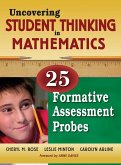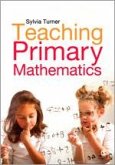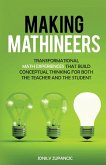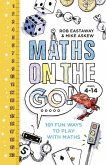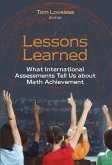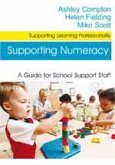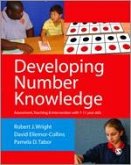Cheryl M. Rose, Carolyn B. Arline
Uncovering Student Thinking in Mathematics, Grades 6-12
30 Formative Assessment Probes for the Secondary Classroom
Cheryl M. Rose, Carolyn B. Arline
Uncovering Student Thinking in Mathematics, Grades 6-12
30 Formative Assessment Probes for the Secondary Classroom
- Gebundenes Buch
- Merkliste
- Auf die Merkliste
- Bewerten Bewerten
- Teilen
- Produkt teilen
- Produkterinnerung
- Produkterinnerung
Discussing standards, research, and more, these 30 probes help secondary teachers assess students' grasp of core mathematics concepts and modify their instruction to improve student achievement.
Andere Kunden interessierten sich auch für
![Uncovering Student Thinking in Mathematics Uncovering Student Thinking in Mathematics]() Cheryl M. RoseUncovering Student Thinking in Mathematics91,99 €
Cheryl M. RoseUncovering Student Thinking in Mathematics91,99 €![Teaching Primary Mathematics Teaching Primary Mathematics]() Sylvia TurnerTeaching Primary Mathematics180,99 €
Sylvia TurnerTeaching Primary Mathematics180,99 €![Making Mathineers Making Mathineers]() Jonily ZupancicMaking Mathineers20,99 €
Jonily ZupancicMaking Mathineers20,99 €![Maths on the Go: 101 Fun Ways to Play with Maths Maths on the Go: 101 Fun Ways to Play with Maths]() Rob EastawayMaths on the Go: 101 Fun Ways to Play with Maths16,99 €
Rob EastawayMaths on the Go: 101 Fun Ways to Play with Maths16,99 €![Lessons Learned Lessons Learned]() Lessons Learned90,99 €
Lessons Learned90,99 €![Supporting Numeracy Supporting Numeracy]() Ashley ComptonSupporting Numeracy160,99 €
Ashley ComptonSupporting Numeracy160,99 €![Developing Number Knowledge Developing Number Knowledge]() Robert J WrightDeveloping Number Knowledge180,99 €
Robert J WrightDeveloping Number Knowledge180,99 €-
-
-
Discussing standards, research, and more, these 30 probes help secondary teachers assess students' grasp of core mathematics concepts and modify their instruction to improve student achievement.
Hinweis: Dieser Artikel kann nur an eine deutsche Lieferadresse ausgeliefert werden.
Hinweis: Dieser Artikel kann nur an eine deutsche Lieferadresse ausgeliefert werden.
Produktdetails
- Produktdetails
- Verlag: Corwin
- Seitenzahl: 250
- Erscheinungstermin: 3. Juli 2008
- Englisch
- Abmessung: 286mm x 221mm x 18mm
- Gewicht: 898g
- ISBN-13: 9781412963763
- ISBN-10: 1412963761
- Artikelnr.: 24373860
- Herstellerkennzeichnung
- Libri GmbH
- Europaallee 1
- 36244 Bad Hersfeld
- gpsr@libri.de
- Verlag: Corwin
- Seitenzahl: 250
- Erscheinungstermin: 3. Juli 2008
- Englisch
- Abmessung: 286mm x 221mm x 18mm
- Gewicht: 898g
- ISBN-13: 9781412963763
- ISBN-10: 1412963761
- Artikelnr.: 24373860
- Herstellerkennzeichnung
- Libri GmbH
- Europaallee 1
- 36244 Bad Hersfeld
- gpsr@libri.de
Cheryl Rose Tobey is the senior program director for mathematics at the Maine Mathematics and Science Alliance (MMSA). Her work at the MMSA is primarily in the areas of leadership, mathematics professional development, and school reform. She is currently the coprincipal investigator of the mathematics section of the NSF-funded project Curriculum Topic Study and principal investigator and project director of a Title IIa State Mathematics and Science Partnership Project, MATHS (Mathematics: Access and Teaching in High School). Prior to working on these projects, Tobey was the coprincipal investigator and project director for MMSA's NSF-funded Local Systemic Change Initiative, BEAMM (Broadening Educational Access to Mathematics in Maine), and was a fellow in the Cohort 4 of the National Academy for Science and Mathematics Education Leadership.
Foreword by Johnny W. Lott Preface Acknowledgments About the Authors 1. Mathematics Assessment Probes Introduction What Types of Understandings and Misunderstandings Does a Mathematics Assessment Probe Uncover? How Were the Mathematics Assessment Probes Developed? What Is the Structure of a Mathematics Assessment Probe? What Additional Information Is Provided With Each Mathematics Assessment Probe? What Mathematics Assessment Probes Are Included in the Book? 2. Instructional Implications Differentiating Instruction Assessing Points of Entry Analyzing Trends in Student Thinking Giving Student Interviews Promoting Student-to-Student Dialogue Developing Vocabulary Allowing for Individual Think Time Improving Students
Process Skills Assessing Effectiveness of Instructional Activities Moving Beyond the Individual Classroom Summary 3. Number and Operations Assessment Probes Probe 1: What Is the Value of the Digit? Teachers
Notes: What Is the Value of the Digit? Probe 1a: What Is the Value of the Digit? Variation Probe 2: What Is the Meaning of 2/3? Teachers
Notes: What Is the Meaning of 2/3? Probe 2a: What Is the Meaning of 2/3? Variation Probe 3: Is It Equivalent? Teachers
Notes: Is It Equivalent? Probe 3a: Is It Equivalent? Variation Probe 4: What
s Your Estimate? Teachers
Notes: What
s Your Estimate? Probe 5: Is It an Estimate? Teachers
Notes: Is It an Estimate? Probe 6: Is It Simplified? Teachers
Notes: Is It Simplified? Probe 6a: Is It Simplified? Algebraic Variation Probe 7: Where Is a Million? Teachers
Notes: Where Is a Million? Probe 8: How Low Can You Go? Teachers' Notes: How Low Can You Go? Probe 8a: How Low Can You Go? Variation Probe 9: What's Your Addition Strategy? Teachers' Notes: What's Your Addition Strategy? Probe 9a: What's Your Addition Strategy? Decimals Variation Probe 9b: What's Your Addition Strategy? Fractions Variation Probe 10: What's Your Subtraction Strategy? Teachers' Notes: What's Your Subtraction Strategy? Probe 10a: What's Your Subtraction Strategy? Decimals Variation Probe 10b: What's Your Subtraction Strategy? Fractions Variation Probe 11: What's Your Multiplication Strategy? Teachers' Notes: What's Your Multiplication Strategy? Probe 11a: What's Your Multiplication Strategy? Decimals Variation Probe 12: What's Your Division Strategy? Teachers' Notes: What's Your Division Strategy? Probe 12a: What's Your Division Strategy? Decimals Variation 4. Geometry, Measurement, and Data Assessment Probes Probe 1: What's the Measure? Teachers' Notes: What's the Measure? Probe 1a: What's the Measure? Variation Probe 2: Are Area and Perimeter Related? Teachers' Notes: Are Area and Perimeter Related? Probe 3: What's the Area? Teachers' Notes: What's the Area? Probe 4: What's the Capacity? Teachers' Notes: What's the Capacity? Probe 5: Is It Transformed? Teachers' Notes: Is It Transformed? Probe 6: Are They Similar? Teachers' Notes: Are They Similar? Probe 7: What Do You Mean? Teachers' Notes: What Do You Mean? Probe 7a: What Do You Mean? Variation Probe 8: Name of the Graph? Teachers' Notes: Name of the Graph? Probe 9: Graph Construction? Teachers' Notes: Graph Construction? 5. Algebra and Data Assessment Probes Probe 1: Equal or Not Equal? Teachers' Notes: Equal or Not Equal? Probe 2: Is It the Same as a+b? Teachers' Notes: Is It the Same as a+b? Probe 3: M & N's? Teachers' Notes: M & N's? Probe 4: What's the Substitute? Teachers' Notes: What's the Substitute? Probe 5: Is It True? Teachers' Notes: Is It True? Probe 6: Solving Equations? Teachers' Notes: Solving Equations? Probe 7: Correct Representation of the Inequality? Teachers' Notes: Correct Representation of the Inequality? Probe 8: Is It a Variable? Teachers' Notes: Is It a Variable? Probe 9: Binomial Expansion? Teachers' Notes: Binomial Expansion? Probe 10: Is It Quadratic? Teachers' Notes: Is It Quadratic? Resource A: Note Template for QUEST Cycle References Index
Process Skills Assessing Effectiveness of Instructional Activities Moving Beyond the Individual Classroom Summary 3. Number and Operations Assessment Probes Probe 1: What Is the Value of the Digit? Teachers
Notes: What Is the Value of the Digit? Probe 1a: What Is the Value of the Digit? Variation Probe 2: What Is the Meaning of 2/3? Teachers
Notes: What Is the Meaning of 2/3? Probe 2a: What Is the Meaning of 2/3? Variation Probe 3: Is It Equivalent? Teachers
Notes: Is It Equivalent? Probe 3a: Is It Equivalent? Variation Probe 4: What
s Your Estimate? Teachers
Notes: What
s Your Estimate? Probe 5: Is It an Estimate? Teachers
Notes: Is It an Estimate? Probe 6: Is It Simplified? Teachers
Notes: Is It Simplified? Probe 6a: Is It Simplified? Algebraic Variation Probe 7: Where Is a Million? Teachers
Notes: Where Is a Million? Probe 8: How Low Can You Go? Teachers' Notes: How Low Can You Go? Probe 8a: How Low Can You Go? Variation Probe 9: What's Your Addition Strategy? Teachers' Notes: What's Your Addition Strategy? Probe 9a: What's Your Addition Strategy? Decimals Variation Probe 9b: What's Your Addition Strategy? Fractions Variation Probe 10: What's Your Subtraction Strategy? Teachers' Notes: What's Your Subtraction Strategy? Probe 10a: What's Your Subtraction Strategy? Decimals Variation Probe 10b: What's Your Subtraction Strategy? Fractions Variation Probe 11: What's Your Multiplication Strategy? Teachers' Notes: What's Your Multiplication Strategy? Probe 11a: What's Your Multiplication Strategy? Decimals Variation Probe 12: What's Your Division Strategy? Teachers' Notes: What's Your Division Strategy? Probe 12a: What's Your Division Strategy? Decimals Variation 4. Geometry, Measurement, and Data Assessment Probes Probe 1: What's the Measure? Teachers' Notes: What's the Measure? Probe 1a: What's the Measure? Variation Probe 2: Are Area and Perimeter Related? Teachers' Notes: Are Area and Perimeter Related? Probe 3: What's the Area? Teachers' Notes: What's the Area? Probe 4: What's the Capacity? Teachers' Notes: What's the Capacity? Probe 5: Is It Transformed? Teachers' Notes: Is It Transformed? Probe 6: Are They Similar? Teachers' Notes: Are They Similar? Probe 7: What Do You Mean? Teachers' Notes: What Do You Mean? Probe 7a: What Do You Mean? Variation Probe 8: Name of the Graph? Teachers' Notes: Name of the Graph? Probe 9: Graph Construction? Teachers' Notes: Graph Construction? 5. Algebra and Data Assessment Probes Probe 1: Equal or Not Equal? Teachers' Notes: Equal or Not Equal? Probe 2: Is It the Same as a+b? Teachers' Notes: Is It the Same as a+b? Probe 3: M & N's? Teachers' Notes: M & N's? Probe 4: What's the Substitute? Teachers' Notes: What's the Substitute? Probe 5: Is It True? Teachers' Notes: Is It True? Probe 6: Solving Equations? Teachers' Notes: Solving Equations? Probe 7: Correct Representation of the Inequality? Teachers' Notes: Correct Representation of the Inequality? Probe 8: Is It a Variable? Teachers' Notes: Is It a Variable? Probe 9: Binomial Expansion? Teachers' Notes: Binomial Expansion? Probe 10: Is It Quadratic? Teachers' Notes: Is It Quadratic? Resource A: Note Template for QUEST Cycle References Index
Foreword by Johnny W. Lott Preface Acknowledgments About the Authors 1. Mathematics Assessment Probes Introduction What Types of Understandings and Misunderstandings Does a Mathematics Assessment Probe Uncover? How Were the Mathematics Assessment Probes Developed? What Is the Structure of a Mathematics Assessment Probe? What Additional Information Is Provided With Each Mathematics Assessment Probe? What Mathematics Assessment Probes Are Included in the Book? 2. Instructional Implications Differentiating Instruction Assessing Points of Entry Analyzing Trends in Student Thinking Giving Student Interviews Promoting Student-to-Student Dialogue Developing Vocabulary Allowing for Individual Think Time Improving Students
Process Skills Assessing Effectiveness of Instructional Activities Moving Beyond the Individual Classroom Summary 3. Number and Operations Assessment Probes Probe 1: What Is the Value of the Digit? Teachers
Notes: What Is the Value of the Digit? Probe 1a: What Is the Value of the Digit? Variation Probe 2: What Is the Meaning of 2/3? Teachers
Notes: What Is the Meaning of 2/3? Probe 2a: What Is the Meaning of 2/3? Variation Probe 3: Is It Equivalent? Teachers
Notes: Is It Equivalent? Probe 3a: Is It Equivalent? Variation Probe 4: What
s Your Estimate? Teachers
Notes: What
s Your Estimate? Probe 5: Is It an Estimate? Teachers
Notes: Is It an Estimate? Probe 6: Is It Simplified? Teachers
Notes: Is It Simplified? Probe 6a: Is It Simplified? Algebraic Variation Probe 7: Where Is a Million? Teachers
Notes: Where Is a Million? Probe 8: How Low Can You Go? Teachers' Notes: How Low Can You Go? Probe 8a: How Low Can You Go? Variation Probe 9: What's Your Addition Strategy? Teachers' Notes: What's Your Addition Strategy? Probe 9a: What's Your Addition Strategy? Decimals Variation Probe 9b: What's Your Addition Strategy? Fractions Variation Probe 10: What's Your Subtraction Strategy? Teachers' Notes: What's Your Subtraction Strategy? Probe 10a: What's Your Subtraction Strategy? Decimals Variation Probe 10b: What's Your Subtraction Strategy? Fractions Variation Probe 11: What's Your Multiplication Strategy? Teachers' Notes: What's Your Multiplication Strategy? Probe 11a: What's Your Multiplication Strategy? Decimals Variation Probe 12: What's Your Division Strategy? Teachers' Notes: What's Your Division Strategy? Probe 12a: What's Your Division Strategy? Decimals Variation 4. Geometry, Measurement, and Data Assessment Probes Probe 1: What's the Measure? Teachers' Notes: What's the Measure? Probe 1a: What's the Measure? Variation Probe 2: Are Area and Perimeter Related? Teachers' Notes: Are Area and Perimeter Related? Probe 3: What's the Area? Teachers' Notes: What's the Area? Probe 4: What's the Capacity? Teachers' Notes: What's the Capacity? Probe 5: Is It Transformed? Teachers' Notes: Is It Transformed? Probe 6: Are They Similar? Teachers' Notes: Are They Similar? Probe 7: What Do You Mean? Teachers' Notes: What Do You Mean? Probe 7a: What Do You Mean? Variation Probe 8: Name of the Graph? Teachers' Notes: Name of the Graph? Probe 9: Graph Construction? Teachers' Notes: Graph Construction? 5. Algebra and Data Assessment Probes Probe 1: Equal or Not Equal? Teachers' Notes: Equal or Not Equal? Probe 2: Is It the Same as a+b? Teachers' Notes: Is It the Same as a+b? Probe 3: M & N's? Teachers' Notes: M & N's? Probe 4: What's the Substitute? Teachers' Notes: What's the Substitute? Probe 5: Is It True? Teachers' Notes: Is It True? Probe 6: Solving Equations? Teachers' Notes: Solving Equations? Probe 7: Correct Representation of the Inequality? Teachers' Notes: Correct Representation of the Inequality? Probe 8: Is It a Variable? Teachers' Notes: Is It a Variable? Probe 9: Binomial Expansion? Teachers' Notes: Binomial Expansion? Probe 10: Is It Quadratic? Teachers' Notes: Is It Quadratic? Resource A: Note Template for QUEST Cycle References Index
Process Skills Assessing Effectiveness of Instructional Activities Moving Beyond the Individual Classroom Summary 3. Number and Operations Assessment Probes Probe 1: What Is the Value of the Digit? Teachers
Notes: What Is the Value of the Digit? Probe 1a: What Is the Value of the Digit? Variation Probe 2: What Is the Meaning of 2/3? Teachers
Notes: What Is the Meaning of 2/3? Probe 2a: What Is the Meaning of 2/3? Variation Probe 3: Is It Equivalent? Teachers
Notes: Is It Equivalent? Probe 3a: Is It Equivalent? Variation Probe 4: What
s Your Estimate? Teachers
Notes: What
s Your Estimate? Probe 5: Is It an Estimate? Teachers
Notes: Is It an Estimate? Probe 6: Is It Simplified? Teachers
Notes: Is It Simplified? Probe 6a: Is It Simplified? Algebraic Variation Probe 7: Where Is a Million? Teachers
Notes: Where Is a Million? Probe 8: How Low Can You Go? Teachers' Notes: How Low Can You Go? Probe 8a: How Low Can You Go? Variation Probe 9: What's Your Addition Strategy? Teachers' Notes: What's Your Addition Strategy? Probe 9a: What's Your Addition Strategy? Decimals Variation Probe 9b: What's Your Addition Strategy? Fractions Variation Probe 10: What's Your Subtraction Strategy? Teachers' Notes: What's Your Subtraction Strategy? Probe 10a: What's Your Subtraction Strategy? Decimals Variation Probe 10b: What's Your Subtraction Strategy? Fractions Variation Probe 11: What's Your Multiplication Strategy? Teachers' Notes: What's Your Multiplication Strategy? Probe 11a: What's Your Multiplication Strategy? Decimals Variation Probe 12: What's Your Division Strategy? Teachers' Notes: What's Your Division Strategy? Probe 12a: What's Your Division Strategy? Decimals Variation 4. Geometry, Measurement, and Data Assessment Probes Probe 1: What's the Measure? Teachers' Notes: What's the Measure? Probe 1a: What's the Measure? Variation Probe 2: Are Area and Perimeter Related? Teachers' Notes: Are Area and Perimeter Related? Probe 3: What's the Area? Teachers' Notes: What's the Area? Probe 4: What's the Capacity? Teachers' Notes: What's the Capacity? Probe 5: Is It Transformed? Teachers' Notes: Is It Transformed? Probe 6: Are They Similar? Teachers' Notes: Are They Similar? Probe 7: What Do You Mean? Teachers' Notes: What Do You Mean? Probe 7a: What Do You Mean? Variation Probe 8: Name of the Graph? Teachers' Notes: Name of the Graph? Probe 9: Graph Construction? Teachers' Notes: Graph Construction? 5. Algebra and Data Assessment Probes Probe 1: Equal or Not Equal? Teachers' Notes: Equal or Not Equal? Probe 2: Is It the Same as a+b? Teachers' Notes: Is It the Same as a+b? Probe 3: M & N's? Teachers' Notes: M & N's? Probe 4: What's the Substitute? Teachers' Notes: What's the Substitute? Probe 5: Is It True? Teachers' Notes: Is It True? Probe 6: Solving Equations? Teachers' Notes: Solving Equations? Probe 7: Correct Representation of the Inequality? Teachers' Notes: Correct Representation of the Inequality? Probe 8: Is It a Variable? Teachers' Notes: Is It a Variable? Probe 9: Binomial Expansion? Teachers' Notes: Binomial Expansion? Probe 10: Is It Quadratic? Teachers' Notes: Is It Quadratic? Resource A: Note Template for QUEST Cycle References Index


